Hundred Years War
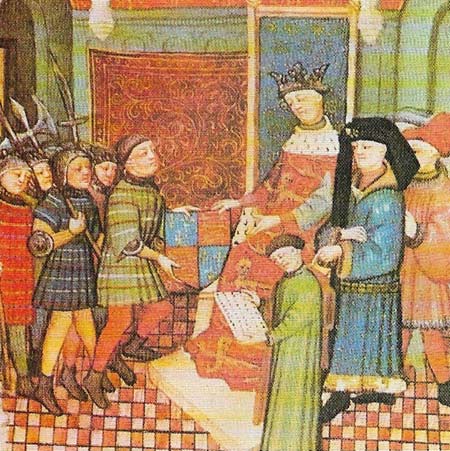
Figure 1. The fleur-de-lys was incorporated in the newly designed royal arms of England when Edward III assumed the title of King of France in 1340. He acted only after securing the support of the Flemish and discontented subjects of France. The arms and title "King of France and England" lasted to 1801.
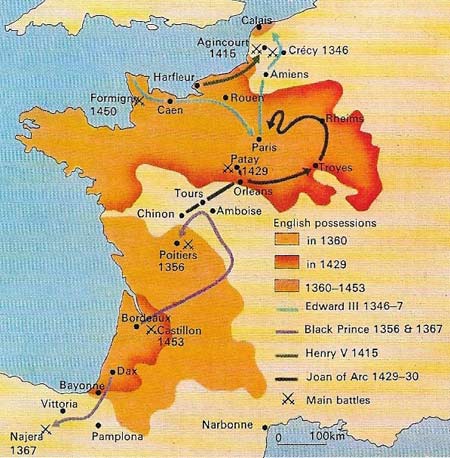
Figure 2. The English campaigns in Gascony and France consisted of plundering raids on most western and northern France. Except for a few captured strongholds, from which ambitious and profitable expeditions could be launched, there was little attempt to conquer French territory until Henry V invaded Normandy early in 1417.
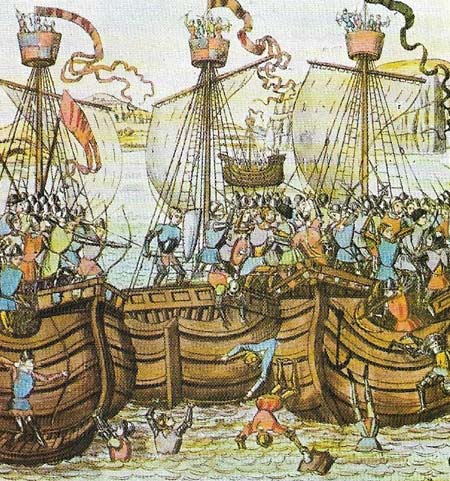
Figure 3. Control of the Channel gave a decisive advantage in war and up to 1340 the French, with the help of the Genoese admiral Barbanera, had been able to raid Southampton and show their flag at the mouth of the Thames. The decisive Battle of Sluys in which English vessels won the first important naval engagement in their history, marked the turning point. At the Battle of La Rochelle (shown here), fought in 1372, the Castilians, who were allied to the French, surprised an English fleet taking reinforcements to Gascony. This defeat ended the English domination of the Channel and was followed by defeat for the army in Gascony, marking a decline in the military fortunes of Edward III.
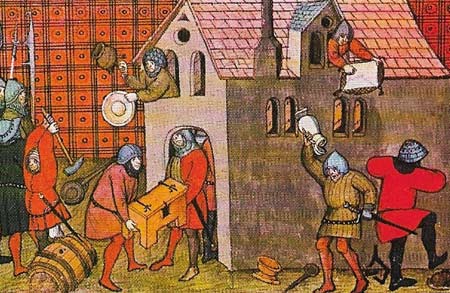
Figure 4. Plunder was one of the main reasons why ordinary soldiers took part in the war, regularly supplementing their wages. It could be acquired in two ways: by ransom or by capture of a place by storm. When a whole village or town was taken the usual practice was to plunder it and subject the inhabitants to fire and the sword. When the Black Prince took Limoges in 1370 he not only permitted looting but put the entire garrison to death, and after Calais fell it was said that "every Englishwoman was wearing its booty". The profits of war, especially for the victors, were great. When Henry V wanted. To gain the good will of captured towns he managed to restrain his men from looting, but this was exceptional for the times.
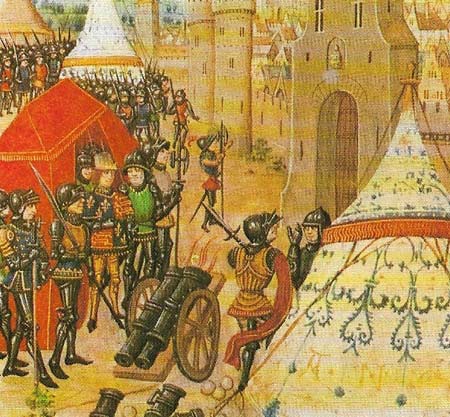
Figure 5. Sieges dominated warfare in the later Middle Ages and were accompanied by strict conventions. Formal siege began when a herald of the besieging party demanded entry in his master's name. Once this was done the besieged could not retreat without dishonor. The Duke of Burgundy excused his failure to take Calais in 1436 by claiming that he had never formally besieged it. If there was no hope of relief for a besieged castle or town, the honorable practice was for the captain to surrender. Mining the walls was the most common form of assault; by 1400 cannons had largely replaced siege engines. The command of a captured garrison was one of the greatest rewards that could be offered to a benefactor of the king, and, like other positions of responsibility, might be highly profitable.

Figure 6. Edward, the Black Prince, the most notable knight of the age, and Victor of Poitiers (1356), took his name from the black armor he wore. This effigy lies on top of his tomb in Canterbury Cathedral.
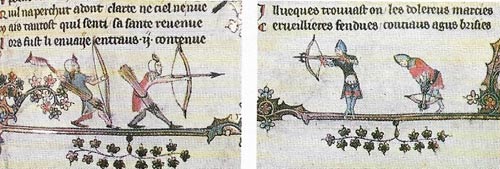
Figure 7. The skill of the English archers paved the way for several victories, the crossbow (right) was an effective weapon that had been used to deadly effect in the Crusades. It was more accurate than the longbow over short distances and had greater force, but it could not fire more than one arrow every 30 seconds. The longbow, 1.83 meters (6 feet) long, could fire as many as six arrows in the same time.
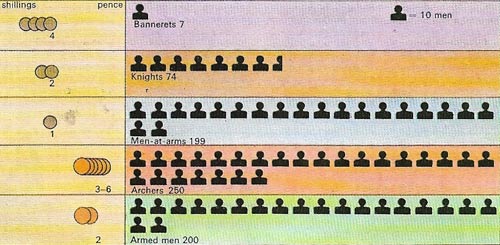
Figure 8. The armies of the Hundred Years War comprised companies recruited and trained by indentured captains who were Noblemen or soldiers distinguished by their military ability. Captains contracted with the king to muster their men and fight in return for wages. They usually led their men in specific military operations, designated in the contract. Captains subcontracted for men-at-arms. The foot soldiers and archers were often volunteers, but many were recruited by "commissions of array" which were appointed for each county. The offer of good wages and free pardons stimulated recruitment, and often there were more volunteers than the king could employ. This diagram shows the retinue of the Earl of Northampton in 1341. The system proved more flexible than the old system of feudal obligations; the short-term contracts were soon applied to peacetime relationships between Lord and servant, and were instrumental in the growth of "bastard feudalism".
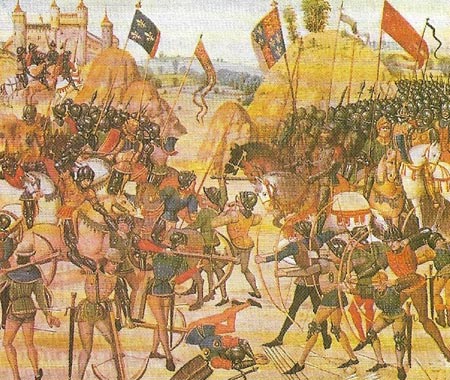
Figure 9. The Battle of Crecy was the first success of the land war, fought when the superior and larger French army overtook Edward's forces who were making for Flanders. English archers checked the French cavalry raid with concentrated fire and the French were almost totally destroyed.
The conflict between the Plantagenet and Valois dynasties, lasting from 1337 to 1453, was marked by short campaigns, longer truces and periods of stalemate. Known as the Hundred Years War, it dominated the history of both England and France in the fourteenth and fifteenth centuries. Even after 1500 the threat of its resumption was a potent weapon in the hands of the English.
The start of the war
The origin of the war lay in the Norman Conquest itself: an Anglo-Norman empire was a reality up to 1204 and its shadow was pursued with energy by Henry III (reigned 1216–1272). Gascony, which the Treaty of Paris (1259) left in English hands but effectively in remote dependence on the French Crown, proved a source of constant dispute. It would have remained merely a legal issue had Edward III (reigned 1327–1377) not laid claim to the French throne (Figure 1) after the death of Charles IV (reigned 1322–1328).
Although Edward's mother was a sister of Charles IV, the French nobles ruled out succession through females and decided that Philip of Valois (1293–1350), as a cousin of Charles, had the best claim. He therefore became king as Philip VI. Despite this setback, Edward did not press his claim until public opinion had been sufficiently aroused by constant pinpricks over Gascony and French support for Scottish independence.
After war began in 1337 and the English won a naval victory at Sluys (1340) Edward relied on the traditional method of recruiting huge armies through subsidies to the princes of Germany and the Low Countries, which cost the English taxpayer enormous sums. Although his clumsy invasion of France ended in disaster through the deceit of his continental allies and shortage of money, the adaptable Edward learned quickly.
After 1340 he employed what could almost be called guerrilla tactics. He acquired footholds on the French coast, strongly fortified, which served as bases for devastating raids on the countryside. This had the advantage of requiring smaller forces than usual. More important, the profits of prisoners' ransoms and the plunder of the country (Figure 4) made the expeditions largely self-supporting and attracted the nobility and ambitious but impoverished knights.
His tactics relied on speed and flexibility against the more numerous but rigidly arrayed mounted knights of France. His archers (Fig 7), although less accurate than the French crossbowmen, were highly effective from carefully chosen positions. At Crecy (1346) (Figure 9) Edward inflicted a crushing defeat with a rain of arrows; at Poitiers his son, Edward the Black Prince (1330–1376) (Fig 6), routed the French cavalry and captured John II (reigned 1350–1364). Perhaps even more important was the capture of a base at Calais (1347) which remained as an English colony for two hundred years. By 1360 both sides were exhausted, and in return for peace at Bretigny the French agreed to abandon Gascony to Edward. From the English point of view the war seemed to have ended in victory.
Fighting for fortunes
Peace, however, proved illusory. The war was not really a conflict between nations: it had become a highly organized business enterprise for the exploitation of France. Individual captains such as Walter Mauny (died 1372) and John Chandos (died 1370) recruited soldiers by "indenture" or contract with pay fora limited period; they themselves signed similar contracts with the king which committed them to bring a specified number of soldiers (Figure 8).
Expeditions or cavalry raids such as that of the Black Prince in 1355–1357 or of John of Gaunt (1340–1399) in 1373 were designed to make a profit for the participants through plunder, levy of tribute from the countryside, and especially through prisoners' ransoms. Such ransoms were divided between the king and the captain who took the prisoner, and they could amount to huge sums. The ransom for King John of France was set at £500,000 (but was never fully paid) and even the humbler prisoners of Mauny were sold by the captain to Edward for £8,000.
The resumption of war
As the war was fought on French soil the English made far more profit than their enemies, and they resumed hostilities in 1369. English victories were less common in the years before a "twenty-eight years' truce" was agreed in 1396.
The most spectacular phase of the war followed the accession of Henry V (reigned 1413–1422). Henry was a military genius who could organize and discipline a large army for years on end, and his renewal of the war was immensely popular. His victory against superior forces at Agincourt (1415), followed by the systematic occupation of Normandy in 1417, was made possible by the feud between the Armagnac and Burgundian factions, and Henry's alliance with Burgundy. By the Treaty of Troyes (1420) Henry married Catherine, the daughter of Charles VI, and was made his heir with the intention of inaugurating a single Anglo-French monarchy. Although he died before this was fulfilled, Henry controlled the whole of northern France with his Burgundian allies, and his infant son, Henry VI (reigned 1422–1460; 1470–1471) held sway in Paris until 1435. By 1453 the revival of the House of Valois finally deprived the English of Normandy and even Gascony.
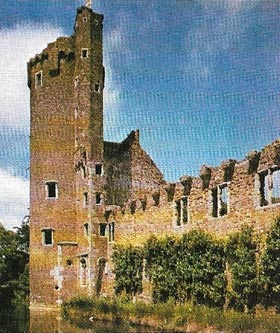 |
| Canister Castle was built by Sir John Fastolf, the successful captain of Henry V and VI, about 1432–1435. Made of brick, crenellated and surrounded by a moat, it cost several thousand pounds and indicates the wealth that Fastolf won in war. After the aggression of Henry V, English policy became more defensive, to preserve the profitable estates and towns from being recaptured, charges of governmental mismanagement of the war became common in the 15th century. |
